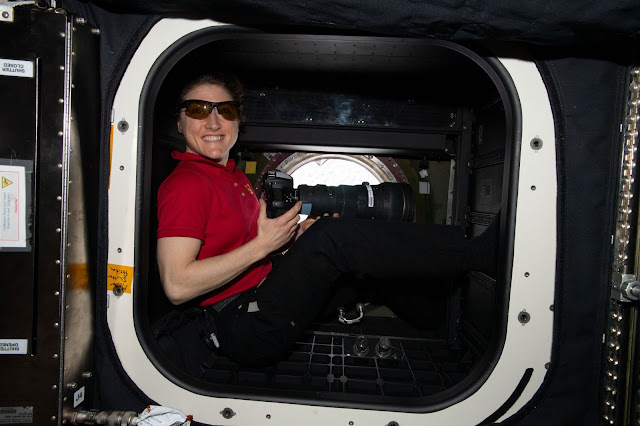ISS - Expedition 60 Mission patch.
Aug. 9, 2019
Astronauts aboard the International Space Station conducted new and ongoing scientific experiments this week, including studies of time perception and microgravity’s effects on brain proteins associated with neurodegenerative diseases and testing a 3D biological printer. The only laboratory that allows scientists to manipulate every variable including gravity, the space station also provides a platform for commercial research and investigations that support Artemis, NASA’s program to return humans to the Moon as a stepping stone to Mars.
Here are details on some of the science conducted on the orbiting laboratory during the week of August 5:
Does anybody really know what time it is?
Image above: NASA astronaut Christina Koch photographs Earth landmarks from the U.S. Destiny laboratory module's Window Observation Research Facility (WORF). Koch is wearing specialized goggles to protect her eyes from the Sun's rays. Image Credit: NASA.
The accurate perception of objects in the environment is critical for a person’s spatial orientation and reliable performance of motor tasks. Time perception in microgravity also is fundamental to motion perception, sound localization, speech, and fine motor coordination. The Time Perception experiment uses a laptop program that induces visual and audio stimuli and measures a subject's response to spatial and time perception. The goal is to quantify subjective changes in time perception that people experience during and after long-duration exposure to microgravity. Crew members performed experiment sessions using a head-mounted Oculus Rift display and headphones and a finger trackball.
Making printing a pancreas a possibility
Image above: NASA astronaut Andrew Morgan works on setting up the BioFabrication Facility to test-print tissues as part of an investigation into whether human organs can be 3D printed in the weightless environment of space. Image Credit: NASA.
The crew performed cassette installations, swaps and removals to test the new BioFabrication Facility (BFF) and encountered some difficulties with several of the smart pumps. To address these issues, the crew manually adjusted, inspected and cleaned the pumps and the ground team reported the activity appears to have been successful. Science and medicine envision using 3D biological printers to produce usable human organs, but printing complex structures inside organs, such as capillary structures, has proven difficult in Earth’s gravity. The BFF is designed to print organ-like tissues in microgravity as a step toward manufacturing human organs in space using refined biological 3D printing techniques.
A bank for something better than money
The crew collected samples for the NASA Repository investigation. A storage bank that maintains biological specimens over extended periods of time and under well-controlled conditions, Repository supports scientific discovery of fundamental knowledge about human physiological changes in and adaptation to microgravity. The samples provide unique opportunities for longitudinal studies of changes in human physiology spanning many missions and are a resource for future space flight-related research. Samples collected from crew members, including blood and urine, are processed and archived before, during and after flight.
The brain on microgravity
Animation above: NASA astronauts Nick Hague and Christina Koch work in the Life Sciences Glovebox on the Cell Science-02 investigation, which examines how microgravity affects healing, tissue regeneration and agents that induce healing. Animation Credit: NASA.
The Amyloid Aggregation investigation assesses whether microgravity affects formation of amyloid fibrils, which could represent a possible risk to astronauts on long flights. Amyloid fibrils are self-assembled fibrous protein aggregates that are associated with a number of neurodegenerative diseases such as Alzheimer’s and Parkinson’s. Better understanding of the mechanism underlying amyloid aggregation could protect astronauts on long missions and contribute to design of treatments for these diseases on Earth. The crew activated samples for the investigation and returned them to cold stowage.
Other investigations on which the crew performed work:
- ACME Flame Design, which studies the production and control of soot to optimize oxygen-enriched combustion and the design of robust, soot-free flames, is part of a series of independent ACME experiments using the orbiting laboratory’s Combustion Integrated Rack (CIR):
https://www.nasa.gov/mission_pages/station/research/experiments/explorer/Investigation.html?#id=1651
https://www.nasa.gov/mission_pages/station/research/experiments/explorer/Facility.html?#id=317
- The European Space Agency’s GRIP experiment tests the ability of astronauts to manipulate items and control their arm motions in space: https://www.nasa.gov/mission_pages/station/research/experiments/explorer/Investigation.html?#id=1188
- Lighting Effects studies the effects that replacing fluorescent light bulbs on the space station with solid-state light-emitting diodes (LEDs) has on crew member circadian rhythms, sleep, and cognitive performance:
https://www.nasa.gov/mission_pages/station/research/experiments/explorer/Investigation.html?#id=2013
- The ISS Experience creates short virtual reality videos from footage taken during the yearlong investigation covering different aspects of crew life, execution of science and the international partnerships involved on the space station:
https://www.nasa.gov/mission_pages/station/research/experiments/explorer/Investigation.html?#id=7877
- The Cell Science-02 investigation examines how microgravity affects healing, tissue regeneration and agents that induce healing:
https://www.nasa.gov/mission_pages/station/research/experiments/explorer/Investigation.html?#id=1676
- The Actiwatch is a wristwatch-like monitor containing an accelerometer to measure motion and color sensitive photodetectors for monitoring ambient lighting to help analyze the crew’s circadian rhythms, sleep-wake patterns and activity:
https://www.nasa.gov/mission_pages/station/research/experiments/explorer/Facility.html?#id=838
- Food Acceptability examines changes in the appeal of food aboard the space station during long-duration missions. “Menu fatigue” from repeatedly consuming a limited choice of foods may contribute to the loss of body mass often experienced by crew members, potentially affecting astronaut health, especially as mission length increases:
https://www.nasa.gov/mission_pages/station/research/experiments/explorer/Investigation.html?#id=7562
- Rodent Research-17 (RR-17) uses young and old mice to evaluate the physiological, cellular and molecular effects of microgravity and spaceflight:
https://www.nasa.gov/mission_pages/station/research/experiments/explorer/Investigation.html?#id=7992
Space to Ground: A New Mission: 08/09/2019
Related links:
Expedition 60: https://www.nasa.gov/mission_pages/station/expeditions/expedition60/index.html
Artemis: https://www.nasa.gov/artemis
Time Perception: https://www.nasa.gov/mission_pages/station/research/experiments/explorer/Investigation.html?#id=7504
BioFabrication Facility (BFF): https://www.nasa.gov/mission_pages/station/research/experiments/explorer/Facility.html?#id=7599
Repository: https://www.nasa.gov/mission_pages/station/research/experiments/explorer/Investigation.html?#id=954
Amyloid Aggregation: https://www.nasa.gov/mission_pages/station/research/experiments/explorer/Investigation.html?#id=7902
Spot the Station: https://spotthestation.nasa.gov/
Space Station Research and Technology: https://www.nasa.gov/mission_pages/station/research/index.html
International Space Station (ISS): https://www.nasa.gov/mission_pages/station/main/index.html
Images (mentioned), Animation (mentioned), Video (NASA), Text, Credits: NASA/Michael Johnson/Vic Cooley, Lead Increment Scientist Expedition 60.
Best regards, Orbiter.ch




